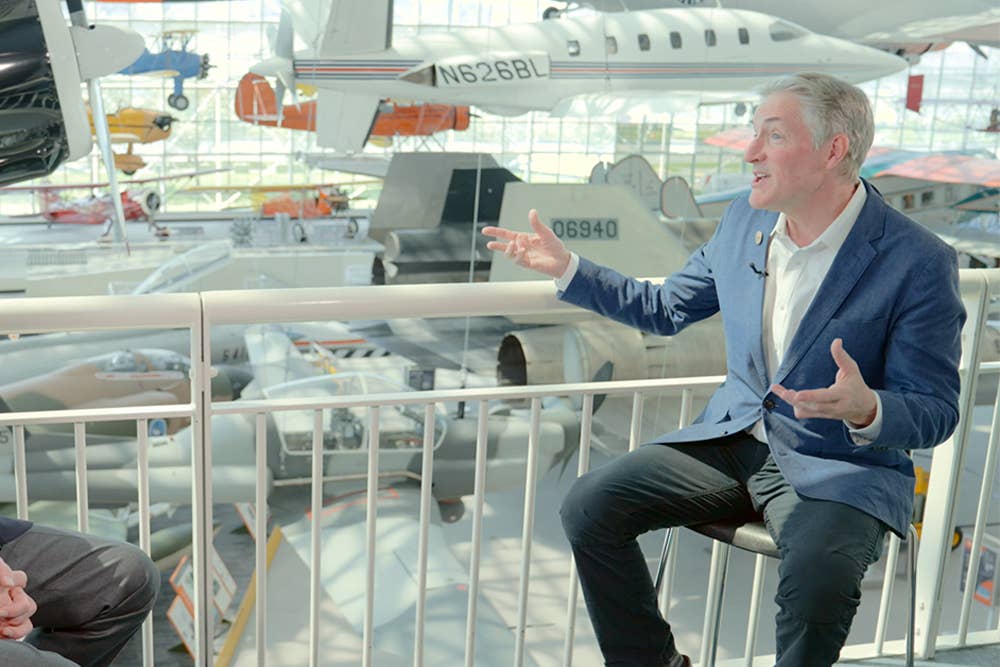
Ed Bolen and Erik Lindbergh sat down for a discussion about sustainable-aviation initiatives—including a new XPRIZE—that the aviator and entrepreneur has been involved with recently. Courtesy NBAA
Aviator, artist, and entrepreneur Erik Lindbergh has taken his family legacy and translated it into a vision for the carbon-free, multimodal future of aviation. Lindbergh—”a name synomous with aviation and sustainability”—spoke with NBAA president and CEO, Ed Bolen, at the Museum of Flight in Seattle in a prerecorded interview opening EBACE Connect on Tuesday, May 18, 2021.
For those who are not familiar with Lindbergh’s personal connection to aviation, here’s an excerpt from the EBACE Connect site: “In 2002, Erik Lindbergh retraced his grandfather’s famous transatlantic solo in a single-engine Lancair Columbia 300. That flight raised over $1 million for the XPRIZE [Foundation] and gave birth to the commercial spaceflight industry. Having made history, Lindbergh today is at work making the future. He is a co-founder of VerdeGo Aero, a company designing engines for advanced air mobility vehicles.” Through these and other efforts, he pushes forward on the same path as The Lindbergh Foundation, which focused his grandparents’ interest and contributions towards the intersection of conservation and aviation and continues to do so today.
“Before my grandfather flew across the Atlantic in 1927 for that prize, people who flew…in airplanes were called barnstormers and daredevils—and after he flew across the Atlantic people who flew in airplanes were called pilots and passengers,” said Lindbergh in the interview. “It was a huge shift in the world’s perspective about what aviation could be used for. I think as we look back on that today, and we think about what the future holds, and how we’re going to get there—how we’re going to fly into the future, sustainability and the ultimate connection that aviation gives us—is really what we need to intersect with…Prize philanthropy is the absolute perfect medium to do that with.” Lindbergh believes strongly that using prizes to break through barriers and create new technologies is a critical motivational tool to help us go where we can’t go through incremental development meted out by government and industry. The latest vision from the XPRIZE Foundation is one designed to drive a breakthrough towards a carbon-free future. The result is the ForeverFlight Alliance, which asks the question: How do we make aviation infinitely sustainable? A $100 million prize lies at stake.
In other news—and looking ahead to commemorate the 100th anniversary of his grandfather’s flight across the Atlantic—Lindbergh laid out his plans for making a hybrid electric flight from New York to Paris, France. Details will evolve along with developments in the technology between now and May 2027. Lindbergh and co-host Lyn Lindbergh are also launching the third season of their podcast, “Second Chances,” which features in-depth interviews with interesting people on that broad subject.
Meshing well with Lindbergh’s message was the EBACE session on sustainability on Wednesday, May 19—”Hydrogen or Electrification: Are We Ready?”—which probed the current state of several key initiatives under the umbrella of sustainable aviation. Panelists included Dr. Anita Sengupta, CEO and founder of Hydroplane (a company developing a modular hydro-electric powerplant); Dr. Patricia Parlevliet, senior research project leader for Airbus Blue Sky (the OEM’s large-scale sustainability initiative); and Sebastiano Fumero, advisor to the European Commission—and moderated by Financial Times aviation contributor Rohit Jaggi. Because private aviation is highly visible—and an easy target—it is the general consensus among those interviewed that this aviation segment must set an example with its efforts to “go green.”
Short- and medium-length flights made with existing and near-term battery technology are the low-hanging fruit, along with sustainable aviation fuel (SAF)—but the greater achievement will lie in hydrogen-driven powerplants (as one example), in order to get the industry to its net-zero-emissions goals by 2050.
“We can’t start with the large commercial airliners,” said Dr. Sengupta—we have to think smaller, which is why business and regional aviation plays an important role. Fumero discussed how the EU governing bodies used “the stick and the carrot” approaches to help drive the industry towards meeting targets set in the Paris Agreement—with the taxing of CO2 emissions (the stick) balanced heavily by the R&D investment the EU is making in public/private partnerships (the carrot). Dr. Parlevliet noted the intermediate steps include widespread use of SAF, with zero-landfill, and zero-waste targets—along with the increased sustainability of hydrogen production itself, as pointed out by Dr. Sengupta, as it currently uses significant amounts of carbon-based fuel in its production.
Registered attendees can view the sessions online at any time. Registration is free for NBAA and EBAA members, and $50 for others.

Subscribe to Our Newsletter
Get the latest FLYING stories delivered directly to your inbox






